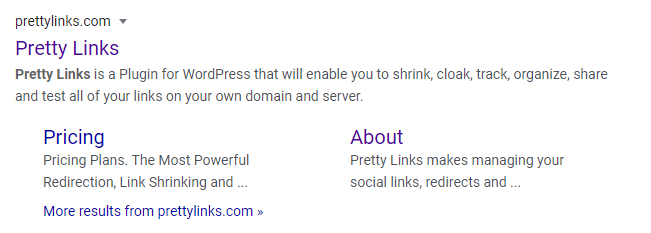Contenido
En primer lugar, debemos aclarar algo sobre las meta descripciones: no son importantes para el sistema de clasificación de Google.
Si hay algo con lo que puedes contar por parte de Google, es con información turbia y oculta sobre lo que es mejor para los motores de búsqueda. Las meta descripciones no están exentas de la oscuridad.
De hecho, incluso la longitud permitida de las descripciones de búsqueda ha subido y bajado a lo largo de los años (saltando a 320 caracteres en diciembre de 2017, solo para volver a bajar a 160 caracteres en mayo de 2018). Mantenerse al día con estos números cambiantes es una batalla frustrante pero necesaria en el camino hacia una mayor tasa de clics (CTR).
Entonces te preguntarás qué sentido tiene el resto de este artículo. Si a Google no le importan las meta descripciones, ¿por qué molestarse en redactarlas de forma experta? Si sus esfuerzos de SEO no se ven recompensados, ¿por qué no saltárselos y pasar a la siguiente táctica de optimización?
Puede que las meta descripciones no formen parte del sistema de clasificación de Google, pero SON una gran ayuda para su estrategia SEO. Ayudan a mejorar las posibilidades de que un usuario haga clic en su sitio y, en ocasiones, son la primera y única oportunidad que tengas.
En esta entrada de blog, vamos a contarte por qué deberías escribir meta descripciones, cómo deberías escribirlas y qué recordar para conseguir el mejor CTR. ¡Vamos a empezar!
¿Qué es una meta descripción?

Empecemos por definir una meta descripción. Según Moz:
La meta descripción es un atributo HTML que proporciona un breve resumen de una página web. Los motores de búsqueda como Google suelen mostrar la meta descripción en los resultados de búsqueda, lo que puede influir en el porcentaje de clics.
Habrá visto alguna vez una meta descripción, aunque no sepa lo que es. Es el extracto que aparece debajo del metatítulo en un resultado de búsqueda.
Es fácil entender por qué estos pequeños descriptores son tan importantes. Pueden ser la única información que tenga un usuario para decidir si hace clic en el enlace a su sitio o se va al de otro. En resumen, las meta descripciones permiten al usuario saber si su página puede o no resolver su problema.
Lo interesante es que Google no siempre muestra tu meta descripción. Una investigación de Moz muestra que Google sólo muestra las meta descripciones personalizadas el 51,3% de las veces. Esto se debe a varios factores, incluyendo la relevancia, y depende en gran medida de las palabras clave utilizadas en la búsqueda del usuario (más sobre esto más adelante).
¿Por qué es importante una meta descripción?

¿Debe escribir una meta descripción? Por supuesto. El SEO consiste en combinar tácticas para impulsar su sitio en los motores de búsqueda, y las meta descripciones son una táctica demasiado fácil como para saltársela.
Considere estas maravillas de dos frases como su cebo para el primer contacto. Después de introducir su búsqueda, la meta descripción es lo primero que verá en la SERP (si el motor ha utilizado su descripción original, por supuesto).
Las meta descripciones también importan porque suelen ser utilizadas por redes sociales para mostrar información cuando se enlaza una página. Omitirlos puede perjudicar sus esfuerzos por compartir en las redes sociales.
¿Cuáles son las mejores meta descripciones?
Las meta descripciones deben seguir todas las reglas de redacción de textos publicitarios: palabras poderosas, verbos y llamadas a la acción. Si alguna vez has visto un Vine cuando estaban de moda, sabrás que más corto no significa menos potente. Más corto puede significar más difícil de ejecutar, ¡pero un golpe poderoso cuando se hace bien!
La descripción debe describir la página al usuario con precisión, pero también convencerle de que la página resolverá su problema. Su descripción debe apoyar esos objetivos.
Elaborar una meta descripción magistral:
- Concéntrate en condensar el punto de tu post de la forma más precisa (y vibrante) posible
- Utiliza palabras clave relevantes (Google las pondrá en negrita en la descripción)
- Utiliza la voz habitual de tu marca
- Indique al usuario qué debe hacer con llamadas directas a la acción
- Comunique primero la información más importante
Tienes 160 caracteres para escribir la meta descripción de tu obra maestra, pero haz lo posible por hacerlo en 155 caracteres. De este modo, tus descripciones aparecerán completas. No siempre es posible mantener esta longitud, ¡y no pasa nada! Todavía puedes ayudar a que tus descripciones aparezcan si:
- Evite los duplicados que podrían parecer chillones cuando se apilan en los resultados de búsqueda
- Utilice llamadas a la acción y palabras clave pertinentes
- Describa lo que realmente hay en su contenido
- ¡Utiliza los verbos!
- No uses comillas (Google cortará tu descripción en la cita)
- Limítese a menos de 155 palabras siempre que sea posible
- Utiliza las mejores prácticas de redacción: estás intentando PERSUADIR
¿Cómo puede asegurarse de que sus meta descripciones aparezcan en Google?
Es importante saber cómo funcionan las meta descripciones para sacarles partido. Los motores de búsqueda buscan palabras clave y frases específicas que un usuario escribe en la búsqueda. Eso significa que tu descripción debe incluir frases que se ajusten lo suficiente a tu contenido como para coincidir con la búsqueda de un usuario.
Existen herramientas que facilitan mucho el proceso. Utilizando un plugin como Todo en uno SEO te ayuda a mantener tus meta descripciones únicas, y también a crearlas y actualizarlas fácilmente.
Consejo: Utilice un rastreador de sitios web como Rana gritona para encontrar páginas o entradas de blog en las que falten meta descripciones. De esta forma podrás optimizar, optimizar y optimizar.
Conclusión
Sus meta descripciones son una parte fácil y esencial de su estrategia SEO. Dominar estas maravillas de dos o tres frases le dará a su buscador optimización un impulso significativo, y todo el mundo podría utilizar ayuda para eso en estos días.
Ten en cuenta nuestras estrategias y estarás escribiendo obras maestras de meta descripción en un abrir y cerrar de ojos.
¿Rellena su meta descripciones en cada post? Cuéntanos tu estrategia en los comentarios.









Deja una respuesta